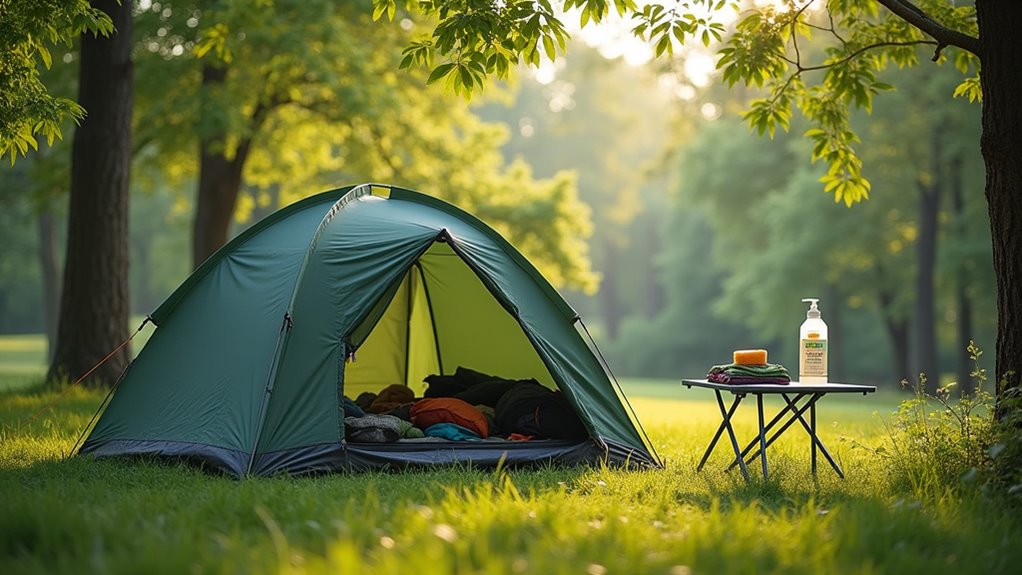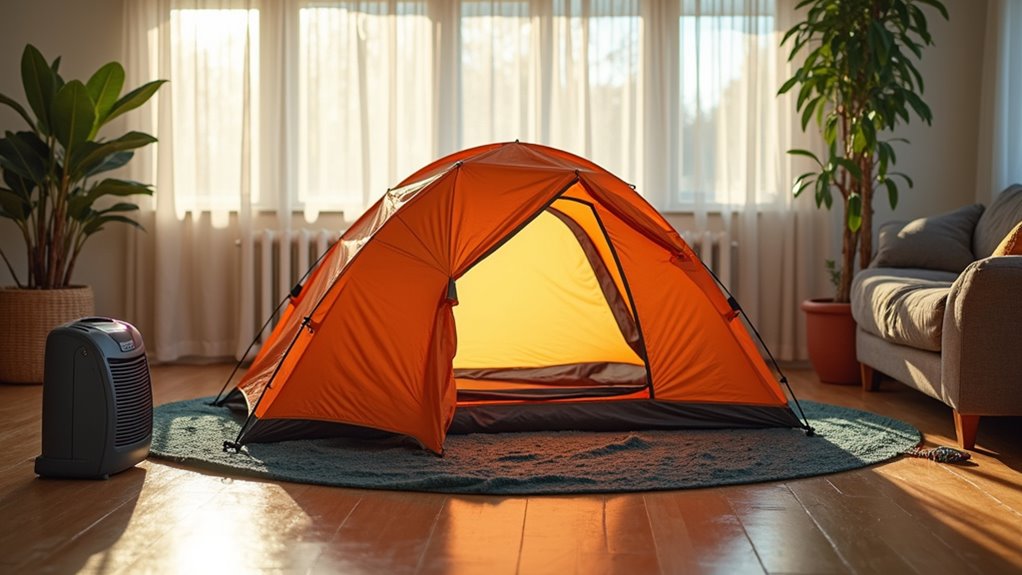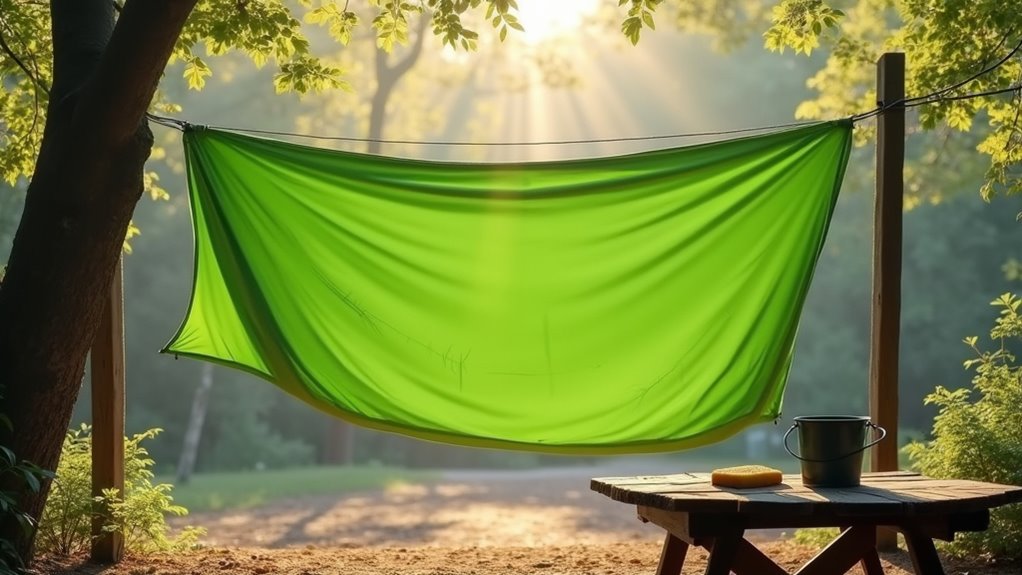How To Dry Tent
This post contains affiliate links. As an Amazon Associate, we earn from qualifying purchases.
The most effective way to dry your tent is to set it up in a well-ventilated area, ensuring all doors and vents are open for maximum airflow. Begin by cleaning the tent to remove dirt and excess moisture, then hang it on a clothesline or branch if possible, avoiding prolonged direct sunlight. Further details and tips on optimizing the drying process will be covered below for those interested in a more thorough explanation.
Essential Facts in 30 Seconds
- Clean the tent and remove excess water before drying.
- Set up the tent in a well-ventilated area with all openings open.
- Use sunlight for drying but avoid prolonged exposure to protect the waterproof coating.
- Hang the tent to allow air circulation on all sides.
- Ensure the tent is completely dry before storage to prevent mildew.
Pre-Drying Preparation

Start by cleaning your tent well. Remove dirt, mud, and leaves from the surface. Use a soft cloth to wipe off extra water, especially on floors, walls, and seams. Shake the tent lightly to drop any hidden water drops. Regular cleaning maintains tent longevity and performance.
Set up the tent in a place with good air flow. Open all doors, windows, and vents wide. This helps the tent dry faster and stops damp spots. If space is tight, hang parts of the tent on chairs or rails. Make sure air reaches every part.
Turn the tent sections now and then to avoid moisture build-up. Check seams and inside layers for wet spots. Give the tent one last wipe to confirm it’s dry. Following these steps keeps your tent in good shape and dries it well. Additionally, ensure the tent is completely dry before storage to prevent mildew growth.
Outdoor Drying Techniques
Dry your tent outdoors by using natural elements to speed up drying. Sunlight helps water evaporate fast. Avoid long sun exposure to protect waterproof coatings. Additionally, consider that proper airflow is crucial for effective drying.
Open all doors, windows, and vents to let air flow freely. Hang the tent on a clothesline or high surface for air all around. Place the tent in shade with good wind to keep fabric safe. Additionally, ensure that the drying location you choose allows for proper airflow to enhance the drying process.
Use a small fan to move air when it’s calm. Shake off extra water before hanging. This cuts drying time a lot. Quick drying keeps your tent ready and fresh for your next trip.
Indoor Drying Considerations

Drying your tent indoors works well when outdoor weather is bad. Remove all extra gear first to make space and improve air flow. Clean the inside of the tent to stop mold and dirt buildup.
Hang the tent with bars or strings, leaving space around it for air to move. Keep the room temperature between 60-70°F (15-21°C). Keep humidity near 50-60%. Use a thermometer and hygrometer to check these numbers often.
Use fans or vents to move air around, but don’t point air directly at the tent. Use a dehumidifier if the air feels too wet. Check the tent for mold regularly. Change airflow or humidity if you see mold spots.
These steps help dry your tent quickly and safely indoors.
Speeding Up Drying
Airflow speeds up the drying of your tent.
Dry fabric means less chance for mold and bad smells. Open all doors, windows, and vents wide. Let fresh air move freely inside. Put your tent where the breeze flows. Use fans to blow cool air over the tent.
Hang your tent on branches or clotheslines. This lets air touch all sides.
Sunlight dries tents fast. Place your tent in the sun and turn it often. Proper storage techniques after drying will help prevent future mustiness. Additionally, making sure your tent is completely dry before packing it away is crucial for avoiding mildew issues.
Dry tents last longer and stay fresh.
Preventing Mold and Mildew

Mold and mildew damage camping gear fast. They cause bad smells and weaken fabric. Stop them early to save your tent. Cleaning mold off your tent is essential for maintaining its longevity.
Store your tent in a cool, dry place. Let air flow inside the tent. Check for damp spots often. Dry the tent fully before putting it away.
Wipe wet surfaces right after use. This lowers moisture that feeds mold. Tents treated for mold resist it better. They last longer and stay cleaner. Regularly inspect for signs of mold growth to ensure your tent remains in good condition.
Try these tips to fight mold and mildew:
| Mold Prevention Tips | Mildew Treatment Methods |
|---|---|
| Keep tent dry and cool | Use white vinegar on moldy spots |
| Ventilate tent during use | Wash with warm, soapy water |
| Inspect for dampness regularly | Scrub gently to remove mildew |
| Dry tent completely before storage | Use Revivex Pro Cleaner for tough mildew |
| Avoid bleach to protect fabric |
Good airflow stops humidity. Mold grows in damp, still air. Clean your tent often to keep it fresh. This keeps your gear strong and ready for camping trips.
Frequently Asked Questions
How Long Does It Typically Take to Dry a Tent?
Drying a tent usually takes from 30 minutes to a few days. Sunlight and good airflow help tents dry faster. A warm, dry place speeds up drying. Hanging the tent fully open lets air flow inside. Avoid packing a wet tent. Damp tents can get mold and smell bad. Use a clean cloth to wipe off water first. Strong wind and sun can dry tents in less than an hour. In cool or damp weather, drying might take longer. Always dry your tent before storing it to keep it fresh.
Can I Use a Hairdryer to Dry My Tent?
Using a hairdryer to dry your tent can harm the fabric. The heat may weaken the material or melt coatings. Air drying lets your tent dry safely and keeps it strong. Fans speed up drying without risk. Protect your tent to make it last longer. Choose gentle drying methods for the best care.
Is It Safe to Dry a Tent Near a Heat Source?
Drying a tent near a heat source can cause serious damage. High heat can weaken the fabric and cause it to tear easily. It also encourages mold and mildew growth, which ruins your tent. The best way to dry a tent is to hang it in a well-ventilated area. Sunlight helps dry tents quickly and kills bacteria. Good air circulation keeps your tent fresh and strong. Avoid using heaters, fireplaces, or direct flames for drying. Protect your gear by drying it safely outdoors or in a cool, breezy spot.
What Should I Do if My Tent Smells Musty?
A musty smell in your tent means it needs cleaning. Use an enzyme cleaner to soak the fabric. This breaks down mold and mildew, which cause the bad odor. Let the tent dry fully in the sun. Sunlight helps kill mold spores and freshens the tent. Store your tent in a dry place after each use. Keep it loose, not packed tight, so air can flow. Regular cleaning stops smells from coming back. A clean tent makes camping more fun and healthy.
Can I Store a Wet Tent Temporarily Without Damage?
Storing a wet tent can cause serious damage fast. Moisture traps inside and grows mold or mildew. This weakens the fabric and seams. It lowers the tent’s strength and safety. Dry your tent fully before packing it away. A dry tent lasts longer and works better next time. Mold and mildew can spread quickly, ruining your gear. Air it out in the sun or a dry place. Don’t risk your tent by storing it damp, even for a short time.
Conclusion
Dry your tent well to keep it fresh and last longer. Sunlight works great—it kills germs and dries fast. A fan indoors helps too, especially on cloudy days. Wet tents can grow mold and smell bad. Clean and dry your tent after every trip. This care stops damage and keeps your tent ready. Take a little time; your tent will thank you on the next adventure.
